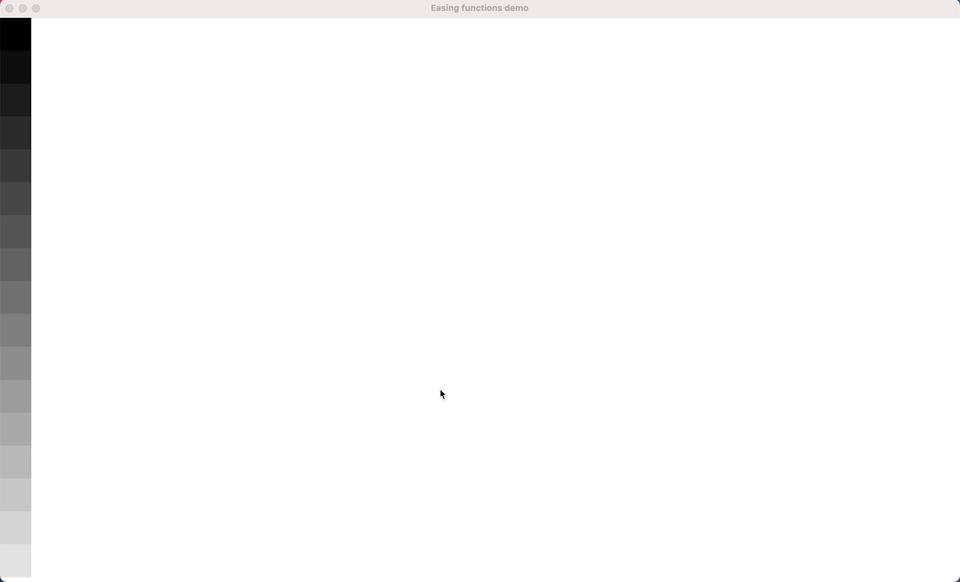rust-animation 

rust-animation is an OpenGL-based graphics library written in Rust for creating hardware-accelerated user interfaces.
It is designed to implement a simple animated UI for embedded devices, inspired by GNOME Clutter project and Apple Core Animation.
The library supports the following features:
- 2D transforms: translate, scale, and rotate
- Animations with easing functions
- Flex UI
- Various examples
Note that rust-animation is still in the early stages of development, so some features may be missing, and there may be bugs. Feel free to file any bugs.
Installation
To use rust-animation, you need to install Rust first:
If you're building rust-animation on Windows or Mac, you'll need to install cmake as well:
For Max OSX,
$ brew install cmake
Note: rust-animation has been tested on Ubuntu 20.04, Windows10, and Mac OSX.
There are several examples so you can build them as follows:
Examples
rust-animation includes several examples to help you get started. To build and run them, you can use the following commands:
easing_functions.rs
This example shows all the available easing functions.
$ cargo build --example easing_functions
$ target/debug/examples/easing_functions
let mut play = Play::new("Easing functions demo".to_string());
play.initialize();
let mut stage = Stage::new("stage".to_string(), 1920, 1080,
LayoutMode::UserDefine, None);
stage.set_visible(true);
let easing_functions = vec![
EasingFunction::EaseIn,
EasingFunction::EaseInCubic,
EasingFunction::EaseInOut,
EasingFunction::EaseInOutCubic,
EasingFunction::EaseInOutQuad,
EasingFunction::EaseInOutQuart,
EasingFunction::EaseInOutQuint,
EasingFunction::EaseInQuad,
EasingFunction::EaseInQuart,
EasingFunction::EaseInQuint,
EasingFunction::EaseOut,
EasingFunction::EaseOutCubic,
EasingFunction::EaseOutQuad,
EasingFunction::EaseOutQuart,
EasingFunction::EaseOutQuint,
EasingFunction::Linear,
EasingFunction::Step
];
let mut y = 0;
let time = 5.0;
let width = 63;
let height = width;
for i in 0..17 {
let actor_name = format!("actor_{}", i+1);
let mut actor = Actor::new(actor_name.to_string(), width, height, None);
actor.x = 0;
actor.y = y;
y += height as i32;
actor.set_color(i as f32 / 18.0, i as f32 / 18.0, i as f32 / 18.0);
actor.apply_translation_x_animation(0, (1920 - width) as i32, time, easing_functions[i]);
actor.apply_rotation_animation(0, 360, time, EasingFunction::Linear);
stage.add_actor(actor);
}
play.add_stage(stage);
while !window.should_close() {
process_events(&mut window, &events);
play.render();
window.swap_buffers();
glfw.poll_events();
}
}
flex_ui.rs
 rust-animation experimentally uses Stretch to support Flex UI. You can apply a Stretch style to a stage or an actor. You can also implement your own layout using a Layout trait.
rust-animation experimentally uses Stretch to support Flex UI. You can apply a Stretch style to a stage or an actor. You can also implement your own layout using a Layout trait.
$ cargo build --example flex_ui
$ target/debug/examples/flex_ui
let mut play = Play::new("Flex UI test".to_string());
play.initialize();
let mut stage = Stage::new("stage".to_string(), 1920, 1080, LayoutMode::Flex, None);
stage.set_style(Style {
size: Size {
width: Dimension::Points(1920.0),
height: Dimension::Points(1080.0),
}, justify_content: JustifyContent::Center,
flex_direction: FlexDirection::Column,
align_items: AlignItems::Center,
margin: Rect {
start: Dimension::Points(1.0),
end: Dimension::Points(1.0),
top: Dimension::Points(1.0),
bottom: Dimension::Points(1.0),
..Default::default()
},
..Default::default()
}
);
stage.set_visible(true);
let justify_content = vec![
JustifyContent::FlexStart,
JustifyContent::FlexEnd,
JustifyContent::Center,
JustifyContent::SpaceBetween,
JustifyContent::SpaceAround,
JustifyContent::SpaceEvenly,
];
let width = 1500;
let height = 108;
for i in 0..6 {
let actor_name = format!("actor_{}", i+1);
let mut actor = Actor::new(actor_name.to_string(), width, height, None);
actor.set_color(i as f32 / 6.0, i as f32 / 6.0, i as f32 / 6.0);
actor.set_style(Style {
size: Size {
width: Dimension::Points(width as f32),
height: Dimension::Points(height as f32),
},
justify_content: justify_content[i],
align_items: AlignItems::Center,
margin: Rect {
start: Dimension::Points(1.0),
end: Dimension::Points(1.0),
top: Dimension::Points(1.0),
bottom: Dimension::Points(1.0),
..Default::default()
},
padding: Rect {
start: Dimension::Points(2.0),
end: Dimension::Points(2.0),
..Default::default()
},
..Default::default()
}
);
for j in 0..10 {
let mut sub_actor = Actor::new(format!("actor_{}_{}", i+1, j+1).to_string(),
100, 100, None);
sub_actor.set_color(1.0, j as f32 / 10.0, j as f32 / 10.0);
actor.add_sub_actor(sub_actor);
}
stage.add_actor(actor);
}
stage.set_needs_layout();
play.add_stage(stage);
ani.rs
$ cargo build --example ani
$ target/debug/examples/ani
This examples shows the basic animation features.
let mut play = Play::new("Animation test".to_string());
play.initialize();
let mut stage = Stage::new("stage".to_string(), 1920, 1080, LayoutMode::UserDefine, None);
stage.set_visible(true);
let mut actor = Actor::new("actor_1".to_string(), 400, 225, None);
actor.x = 100;
actor.y = 100;
actor.set_image("examples/splash.png".to_string());
let time = 5.0;
actor.apply_scale_animation(1.0, 2.0, time, EasingFunction::Linear);
actor.apply_translation_x_animation(100, 1000, time, EasingFunction::EaseInOut);
actor.apply_translation_y_animation(100, 300, time, EasingFunction::EaseInOut);
actor.apply_rotation_animation(0, 360, time, EasingFunction::EaseInOut);
let mut actor_2 = Play::new_actor("actor_2".to_string(), 120, 120, None);
actor_2.x = 100;
actor_2.y = 100;
actor_2.scale_x = 1.5;
actor_2.scale_y = 1.5;
actor_2.set_color(0.0, 0.0, 1.0);
actor_2.apply_rotation_animation(0, 360, 5.0, EasingFunction::EaseInOut);
let mut actor_3 = Play::new_actor("actor_3".to_string(), 50, 50, None);
actor_3.x = 10;
actor_3.y = 10;
actor_3.set_color(1.0, 0.0, 0.0);
actor_2.add_sub_actor(actor_3);
stage.add_actor(actor);
stage.add_actor(actor_2);
stage.set_needs_layout();
play.add_stage(stage);
while !window.should_close() {
process_events(&mut window, &events);
play.render();
window.swap_buffers();
glfw.poll_events();
}
picture_viewer.rs
This example is still work in progress. The thumbnail view only works.
$ cargo build --example picture_viewer
$ target/debug/examples/picture_viewer
This code shows how to handle events and user-defined layout. More event handler methods would be added.
pub struct ActorEvent {
name: String,
}
impl ActorEvent {
pub fn new() -> Self {
ActorEvent {
name: "actor_event".to_string()
}
}
}
impl EventHandler for ActorEvent {
fn key_focus_in(&mut self, actor: &mut Actor) {
println!("key_focus_in: {} {}", self.name, actor.name);
actor.apply_scale_animation(1.0, 1.1, 0.3, EasingFunction::EaseInOut);
}
fn key_focus_out(&mut self, actor: &mut Actor) {
println!("key_focus_out: {} {}", self.name, actor.name);
actor.scale_x = 1.0;
actor.scale_y = 1.0;
}
fn key_down(&mut self, key: usize, actor: &mut Actor) {
println!("key_down: {} {} {}", self.name, key, actor.name);
if key == 262 { actor.select_next_sub_actor();
} else if key == 263 { actor.select_prev_sub_actor();
}
}
}
pub struct ActorLayout {
name: String,
cur_x: i32,
}
impl ActorLayout {
pub fn new() -> Self {
ActorLayout {
name: "actor_layout".to_string(),
cur_x: 0
}
}
}
impl Layout for ActorLayout {
fn layout_sub_actors(&mut self, sub_actor_list: &mut Vec<Actor>) {
println!("layout_sub_layer {}", self.name);
let mut index : i32 = 0;
for sub_actor in sub_actor_list.iter_mut() {
self.cur_x += sub_actor.width as i32;
sub_actor.x = index % 5 * IMAGE_WIDTH as i32;
let col = index / 5;
sub_actor.y = col * IMAGE_HEIGHT as i32;
index +=1;
}
}
}


 rust-animation experimentally uses Stretch to support Flex UI. You can apply a Stretch style to a stage or an actor. You can also implement your own layout using a Layout trait.
rust-animation experimentally uses Stretch to support Flex UI. You can apply a Stretch style to a stage or an actor. You can also implement your own layout using a Layout trait.